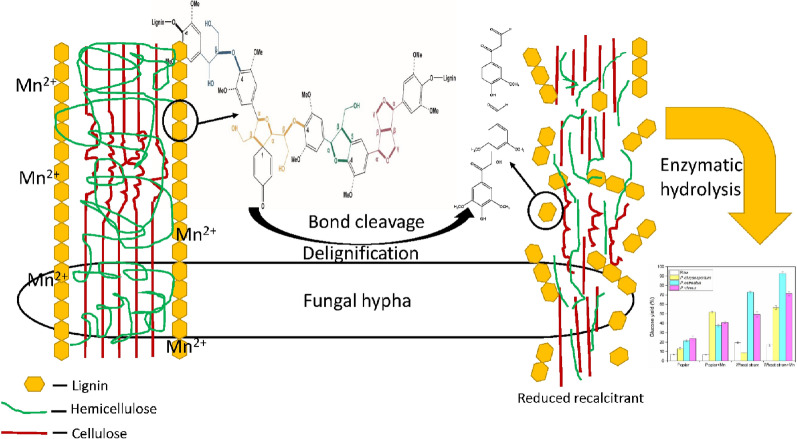- Record: found
- Abstract: found
- Article: found
A comprehensive study of the promoting effect of manganese on white rot fungal treatment for enzymatic hydrolysis of woody and grass lignocellulose

Read this article at
Abstract
Background
The efficiency of biological systems as an option for pretreating lignocellulosic biomass has to be improved to make the process practical. Fungal treatment with manganese (Mn) addition for improving lignocellulosic biomass fractionation and enzyme accessibility were investigated in this study. The broad-spectrum effect was tested on two different types of feedstocks with three fungal species. Since the physicochemical and structural properties of biomass were the main changes caused by fungal degradation, detailed characterization of biomass structural features was conducted to understand the mechanism of Mn-enhanced biomass saccharification.
Results
The glucose yields of fungal-treated poplar and wheat straw increased by 2.97- and 5.71-fold, respectively, after Mn addition. Particularly, over 90% of glucose yield was achieved in Mn-assisted Pleurotus ostreatus-treated wheat straw. A comparison study using pyrolysis gas chromatography mass spectrometry (Py-GC/MS) and two-dimensional 1H– 13C heteronuclear single quantum coherence (2D HSQC) nuclear magnetic resonance (NMR) spectroscopy was conducted to elucidate the role of Mn addition on fungal disruption of the cross-linked structure of whole plant cell wall. The increased C α-oxidized products was consistent with the enhanced cleavage of the major β-O-4 ether linkages in poplar and wheat straw lignin or in the wheat straw lignin–carbohydrate complexes (LCCs), which led to the reduced condensation degree in lignin and decreased lignin content in Mn-assisted fungal-treated biomass. The correlation analysis and principal component analysis (PCA) further demonstrated that Mn addition to fungal treatment enhanced bond cleavage in lignin, especially the β-O-4 ether linkage cleavage played the dominant role in removing the biomass recalcitrance and contributing to the glucose yield enhancement. Meanwhile, enhanced deconstruction of LCCs was important in reducing wheat straw recalcitrance. The findings provided not only mechanistic insights into the Mn-enhanced biomass digestibility by fungus, but also a strategy for improving biological pretreatment efficiency of lignocellulose.
Related collections
Most cited references46
- Record: found
- Abstract: found
- Article: not found
Lignin biosynthesis.
- Record: found
- Abstract: found
- Article: not found
Biological pretreatment of lignocellulosic biomass--An overview.
- Record: found
- Abstract: found
- Article: not found
